 Jack Dazzo was one of my favorite animators as I grew up, but I’d never even heard of him. That’s because commercials don’t have credits. Dazzo is an unsung master of the profession. Unsung, that is, until you talk to the folks he worked with, then his name is constantly raised and praised.
Jack Dazzo was one of my favorite animators as I grew up, but I’d never even heard of him. That’s because commercials don’t have credits. Dazzo is an unsung master of the profession. Unsung, that is, until you talk to the folks he worked with, then his name is constantly raised and praised.
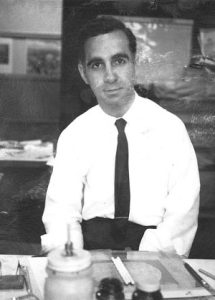 Born in Brooklyn during 1926, Joachim Dazzo got serious about drawing around age 7. Health issues plagued Jack. As a boy, a botched tonsillectomy left a fragment of tooth in his lung. The lung was later removed. At 16 he wrote a letter applying for a job with Disney. The response was that he lived too far away.
Born in Brooklyn during 1926, Joachim Dazzo got serious about drawing around age 7. Health issues plagued Jack. As a boy, a botched tonsillectomy left a fragment of tooth in his lung. The lung was later removed. At 16 he wrote a letter applying for a job with Disney. The response was that he lived too far away.
Jack’s parents wouldn’t let him move to California, so he graduated school in New York and did three years at Pratt Institute. His drawing style was well developed by then.
Showing his portfolio to dozens of art directors brought no jobs. After several months his aunt told Jack about her friend who worked in animation. Jack Dazzo started at Famous Studios as an opaquer on September 18, 1950. Six months later he was an inbetweener, which he described as ‘an assistant to an assistant animator’. He pitched in on POPEYE, CASPER, and LITTLE AUDREY cartoons for theaters. Howard Beckerman was in the inbetweening pool with Jack.
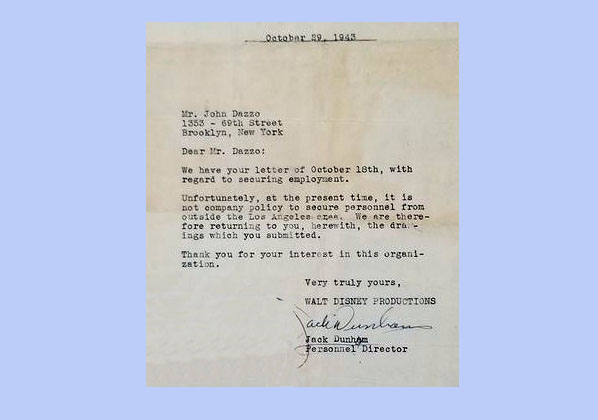





Famous Studios ran a LITTLE AUDREY strip in newspapers. Artists working there were encouraged to submit strips for consideration. Dazzo sold several of them at fifty dollars a pop.
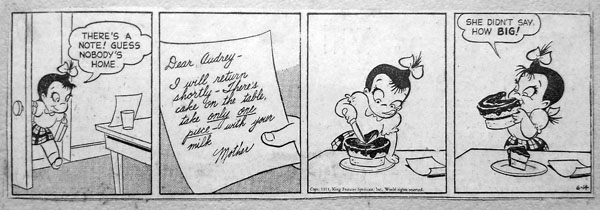
In 1952 Jack married his cousin’s friend Terry. Being at Famous Studios put Jack in a room full of people who loved to draw. The double punch of television and changes in theater regulation would put an end to theatrical cartoons, calling into question how long could a studio that large continue. The number of jobs was about to narrow drastically. Only the most talented would survive. Television commercials made by smaller studios were the future.
Shamus Culhane’s expert eye for talent espied Jack Dazzo in 1953 and took him on as an inbetweener. Four months later Jack got bumped up to Assistant Animator. Guys from Madison Avenue advertising agencies were now involved in the mix. Unavoidable interlopers. Corporate Cash Cows Considered Culhane’s Fare Quality! Jack worked on high profile television ads for major companies: Lipton Tea; Halo Shampoo; Ajax Cleanser; Campbell Soups; Borden Milk; Chesterfield Cigarettes; and the celebrated Mae West parody for Muriel Cigars.
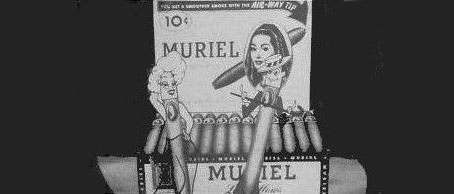
Dazzo remained with Culhane for four years, until the place ran into money trouble. By 1957 Jack had two young daughters, a new house on Staten Island, and a promotion to Apprentice Animator. When Shamus Culhane made the live-action SHOWDOWN AT ULCER GULCH sales film for the Saturday Evening Post, Gordon Whittier animated Ted Keye’s newspaper strip character HAZEL for a short sequence, with Dazzo’s assistance. Dolores Cannata handled art direction on the overall film.
During 1959 Dazzo, Whittier, and Cannata all went to Transfilm, right next door to Famous Studios. In turn, Transfilm was purchased by the Ohio-based Buckeye Corporation, along with Wylde Studios and Caravel Pictures. Buckeye did something to get banned from the Stock Exchange, so in 1961 Jack Dazzo went free-lance. His third daughter had been born. Dazzo did some commercials for Elektra Films and got to know Phil Kimmelman.
Dazzo spent time at Byron Rabbitt’s shop in 1964. When Kimmelman departed Elektra Films later that year, Dazzo was brought in to supervise animation there, making him Director of any animated projects. Dazzo worked closely with producer Jordan Caldwell to bring us memorable ads for Crispy Critters, with gyrating pink elephants, even.
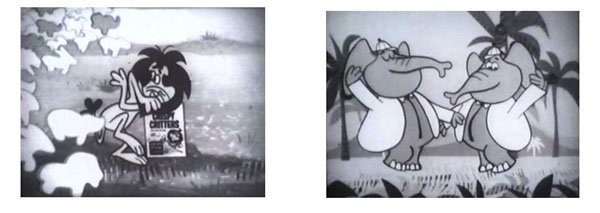
Elektra’s other clients included Scotch Transparent Tape and Morton Salt.
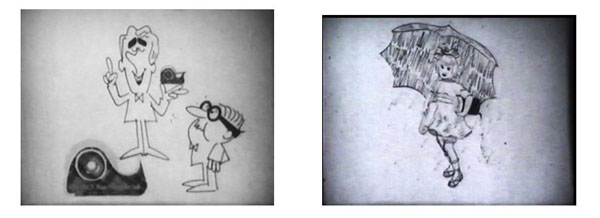
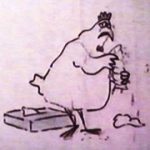 In 1967 Jack Dazzo made a chicken cry. Don’t misunderstand, it wasn’t because Jack wanted to make a chicken cry. Some ad agency paid Jack to make a chicken cry. Actually, the chicken cried because Armour Bacon shrank less, so eggs looked smaller. Jack took on the animation because of his maxim: “Believable action from an un-real idea”.
In 1967 Jack Dazzo made a chicken cry. Don’t misunderstand, it wasn’t because Jack wanted to make a chicken cry. Some ad agency paid Jack to make a chicken cry. Actually, the chicken cried because Armour Bacon shrank less, so eggs looked smaller. Jack took on the animation because of his maxim: “Believable action from an un-real idea”.
Elektra was on fire, paying big salaries, and charging big money. A resonant teleblurb could start a catchphrase craze, or give people something to talk about around the water-cooler.
Well, when you get highly creative types together, and can afford to pay them well,
Crying chickens are certainly not the limit. 1967 also saw ‘Talking Stomach’, in which a man does a therapy session with his stomach.

Those sublime R. O. Blechman designs brought to life by a skilled animator like Jack Dazzo. George Cannata Jr. acted as Creative Director on the project, which won a Clio Award from the advertising community, and a Certificate of Merit from the Art Directors’ Club of New York. Magazine articles were written about Talking Stomach, hailing it as the vanguard in teleblurbs with animation aimed at adults. To be honest, Shamus Culhane’s sexy cigar had broken through that wall fifteen years earlier, but it often takes the culture vultures a while to see what’s under their noses.
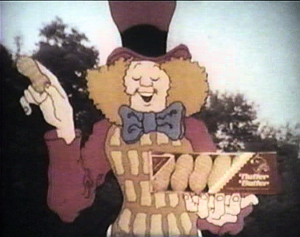 The trend by 1969 was marketing to the younger crowd. The post-war baby boomers were turning 21. Madison Avenue had Dazzo give life to the Nutter Butter Man, who was hip and stylish. Kids could relate. We ten year olds asked no questions and sang the catchy jingle with our friends. Now I look at it and wonder if his body is supposed to be a cookie, or if he’s wearing a plaid corset.
The trend by 1969 was marketing to the younger crowd. The post-war baby boomers were turning 21. Madison Avenue had Dazzo give life to the Nutter Butter Man, who was hip and stylish. Kids could relate. We ten year olds asked no questions and sang the catchy jingle with our friends. Now I look at it and wonder if his body is supposed to be a cookie, or if he’s wearing a plaid corset.
Then it became a race between ad agencies to see who could come up with the most far-out ideas. Elektra was more than prepared to meet their needs. Their Screaming Yellow Zonkers spots went for broke.

Screaming Yellow Zonkers’ “Metamorphosis” ad in 1970 brought more rave reviews, and a certificate from the international animation society ASIFA.
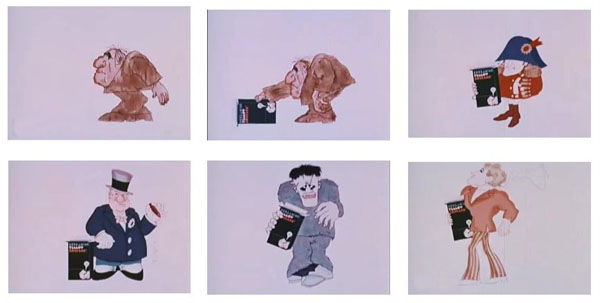
Newspaper cartoonist Johnny Hart was licensing out his B.C. characters, and Dazzo was adapting them into animation for Marathon Oil ads. Of course, during this period the Federal umbrella agency ACTION used B.C. and friends in PSA teleblurbs to boost enlistment in the Peace Corps. B.C. also appeared in the Monroe Shocks ads around this time. I don’t know if Dazzo worked on them.
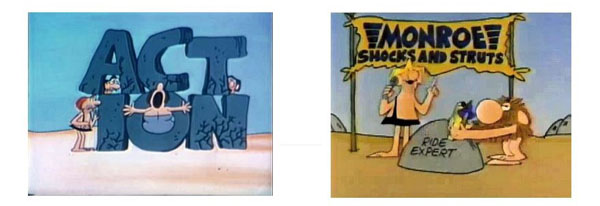

 MPO-Videotronics raided Elektra Films’ staff in 1971, hiring away a number of their best people. Jack became Animation Director of a new subsidiary called Peridot Films, at 222 East 44th Street. Jordan Caldwell was his producer. Jack’s daughter Donna had finished sophomore year of high school, and he gave her a summer job as an opaquer. Donna was proud watching her father take meetings with admen and corporate executives.
MPO-Videotronics raided Elektra Films’ staff in 1971, hiring away a number of their best people. Jack became Animation Director of a new subsidiary called Peridot Films, at 222 East 44th Street. Jordan Caldwell was his producer. Jack’s daughter Donna had finished sophomore year of high school, and he gave her a summer job as an opaquer. Donna was proud watching her father take meetings with admen and corporate executives.
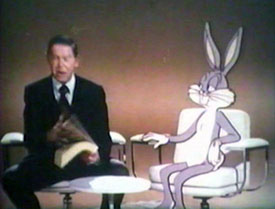 The Marathon Oil account followed Dazzo and Caldwell to Peridot. So did an AT&T campaign pitching the Yellow Pages – sort of a paper version of Google for local phone numbers. Bugs Bunny was animated to interact with live- action celebrities. Milton Berle was one.
The Marathon Oil account followed Dazzo and Caldwell to Peridot. So did an AT&T campaign pitching the Yellow Pages – sort of a paper version of Google for local phone numbers. Bugs Bunny was animated to interact with live- action celebrities. Milton Berle was one.
Elektra Films collapsed after so much talent jumped ship, but Peridot Films was a hot ticket, garnering plenty of favorable write-ups in the media. When I was twelve, Peridot brought us W.C. Fritos. I picked up an imitation of the voice immediately.
 “Hello, my little Chip-a-dees!”. Frito Lay put a FREE pencil-top eraser shaped like the character in Fritos Corn Chips six- packs. It was my prize possession for a while. A demand for educational animation recently came into being. The ABC AFTER SCHOOL SPECIAL had Dazzo create an imaginative opening.
“Hello, my little Chip-a-dees!”. Frito Lay put a FREE pencil-top eraser shaped like the character in Fritos Corn Chips six- packs. It was my prize possession for a while. A demand for educational animation recently came into being. The ABC AFTER SCHOOL SPECIAL had Dazzo create an imaginative opening.

Things weren’t all called peaches-and-cream at Peridot. Dazzo often called Phil Kimmelman to complain about Jordan Caldwell’s manipulations. Fine work continued to be done despite any tensions, pleasing clients like Northeast Airlines and Mars Candy.
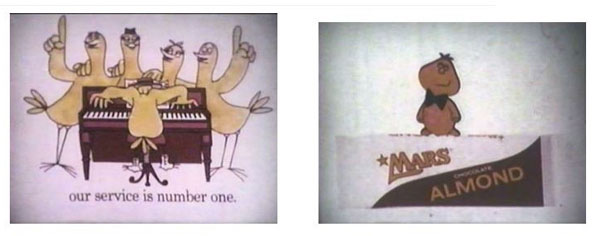
Little is known about the film APPLE. It was animated by Dazzo. It runs two minutes and ten seconds. Peridot Films’ name is on the canister. It looks and sounds a lot like a tribute to Hubley Studios. Possibly an attempt at an art-house short, or a shot at getting an Oscar nomination.

Commercials remained the bread-and-butter. Fruit Pie the Magician came to be. Peridot moved the studio a couple of blocks in 1974 to 305 East 44th Street, and finished moving all the equipment the day before their new location had an explosion that wrecked their part of the building. Everything was destroyed.
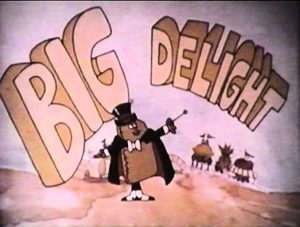 Dazzo and Caldwell parted ways. MPO took over and set up at the original location as Peridot-Videotronics. Jordan Caldwell went into producing live-action commercials. Jack Dazzo was back to freelancing. He worked on the feature-length TUBBY THE TUBA which, despite all the great talent involved, ended up abysmal rotten tomato.
Dazzo and Caldwell parted ways. MPO took over and set up at the original location as Peridot-Videotronics. Jordan Caldwell went into producing live-action commercials. Jack Dazzo was back to freelancing. He worked on the feature-length TUBBY THE TUBA which, despite all the great talent involved, ended up abysmal rotten tomato.
Dazzo freelanced for Pablo Ferro – alongside Arnie Levin. When Levin started Phos-Cine he brought Dazzo in at every opportunity, as did Phil Kimmelman and Associates. Dazzo turned out slick work for Kimmelman and the others.
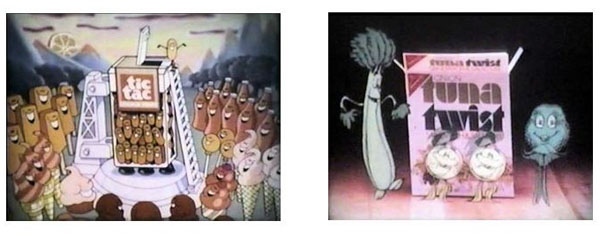
Designer Nick Gaetano emulated painter Henri Rosseau’s flat, colorful style for a Clairol Shampoo ad. Jack Dazzo met the challenge.
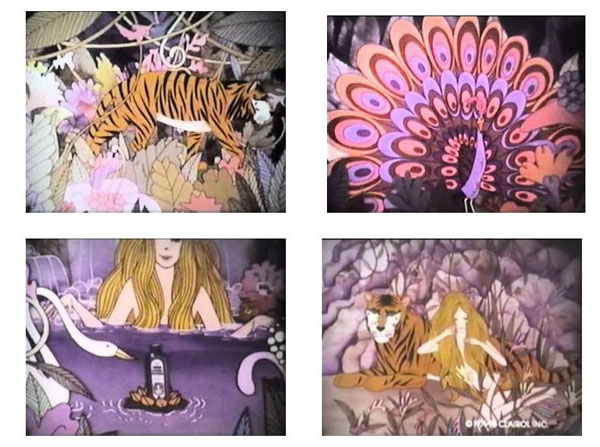
. . . Easily switching gears for the playful Six Flags ads . . .
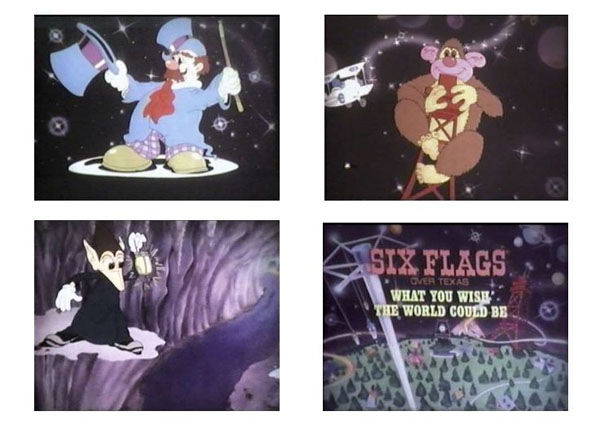
1976 proved a banner year for Jack Dazzo. His Renault commercial channeled singer Maurice Chevalier, though, viewed in a modern light it begets the question of political correctness in portraying a Frenchman as a frog.

That year Dazzo cemented his place as a Pop Culture icon with the SCHOOLHOUSE ROCK episode I’M JUST A BILL.

THE ARCHIES ruled television. SCOOBY DOO and THE ARCHIES ruled television. The best animation was being done in commercials. Dazzo got kids saying “Hi, Drox” to their cookies.
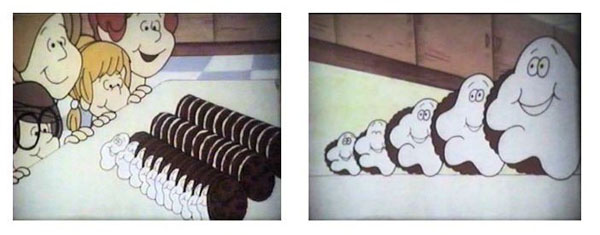
When the Incredible Hulk smashed his way into a tree-house to pillage Honeycomb cereal, Jack Dazzo was behind the pencil.
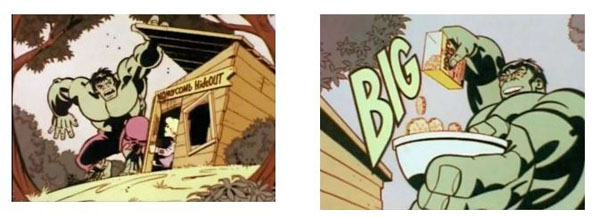
Based on Bill Peckmann’s designs, Jack Dazzo set magical ‘M&Ms Candy Man’ to dancing.

And there was Soup Man for Lipton Ring-O-Noodles rap. And banjo players for Reynolds Wrap.
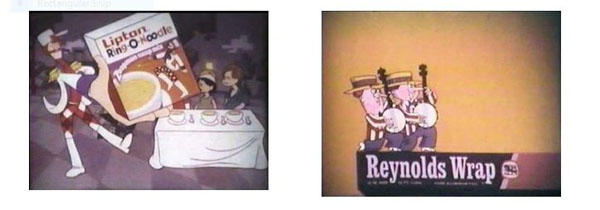
Dazzo revived the Honeycomb Kid.
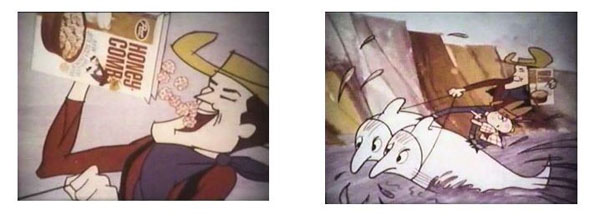
Cereal ads continued to be a mainstay of Dazzo’s output.

Jack Dazzo drew for Shamus Culhane’s half-hour TV specials NOAH’S ANIMALS and KING OF THE BEASTS. Thirty-minute animated specials were fashionable. Al Kouzel directed one for Valentine’s Day, using Bill Kean’s FAMILY CIRCUS characters, with Dazzo on board. Perpetual Motion Pictures hired Jack Dazzo full time in 1979 for THE BERENSTAIN BEARS’ CHRISTMAS TREE.
The day Jack Dazzo arrived, Candy Kugel recalls how the young animators at Perpetual tried not to gawk at the guy whose studio had blown up. Jack was an easy going fellow who would have a beer with the younger animators, but never participated in macho posturing. For that reason some of them disliked him. I’d tell you who they were, but their names are mostly forgotten. The younger crew who embraced Jack were the ones who impacted the industry.

At Perpetual, Dazzo found himself among old friends Gerry Dvorak and Lu Guarnier. It was decided Dazzo would animate the Mother Bear, with Mary Taracka as his main assistant. When Buzz Potamkin quit Perpetual in 1981 to found Buzzco, Jack Dazzo, Candy Kugel, both Vinnies, and the Berenstain Bears went along. More TV specials and commercials followed at Buzzco, until Dazzo semi-retired during 1983.
Jack free-lanced for IF Studios, which did a lot of graphics and titles. He was at Kim & Gifford, Prism, and Zander’s Animation Parlour. Cel Art Service kept Jack’s number handy. Bill Feigenbaum called him in to W-F Productions a few times. KCMP brought Dazzo in for a few days in 1986 for an Underoos ad that used the rotoscope.
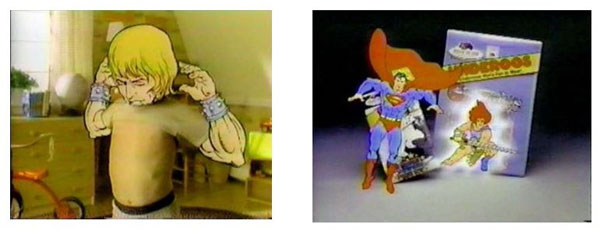
The K in KCMP represented Phil Kimmelman, while the C stood for Jordan Caldwell. They had formed a partnership. Jack Dazzo called it a wrap and settled into his retirement community. His daughter Diane got him started on watercolors. Jack’s other daughter Joanne recalls her father’s life-long fondness for Disney animation. He created cartoons for the newspaper in his retirement community.
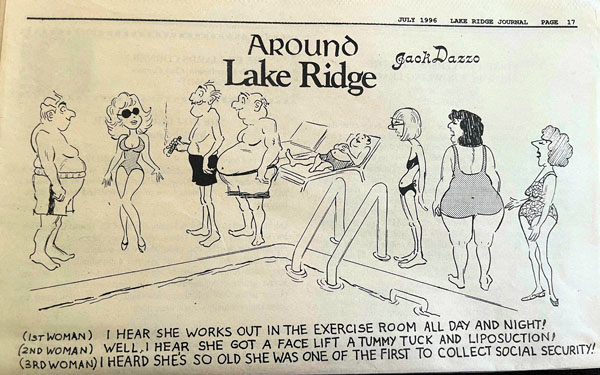
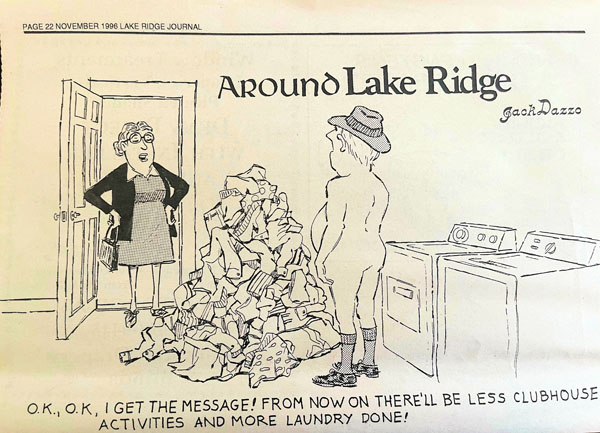
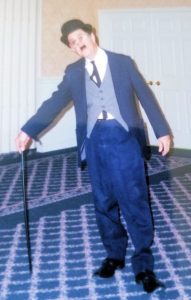 Jack and Terry Dazzo relaxed into a life of socializing. He’d always been noted as easy-going. Kimmelman was wary of ever getting Dazzo excited about a project because of the one lung situation, but Jack got on fine. He played bocce ball, and entertained neighbors with his imitation of Charlie Chaplin.
Jack and Terry Dazzo relaxed into a life of socializing. He’d always been noted as easy-going. Kimmelman was wary of ever getting Dazzo excited about a project because of the one lung situation, but Jack got on fine. He played bocce ball, and entertained neighbors with his imitation of Charlie Chaplin.
Jack Dazzo’s career coincided perfectly with the rise and fall of hand-drawn animated commercials. The new generation with their computer graphics could deal with those annoying advertising agency people. Dazzo’s time behind the pencil no doubt affected the zeitgeist, amusing millions of people over a span of decades. He must be remembered as one of the truly great animators of the teleblurb age.
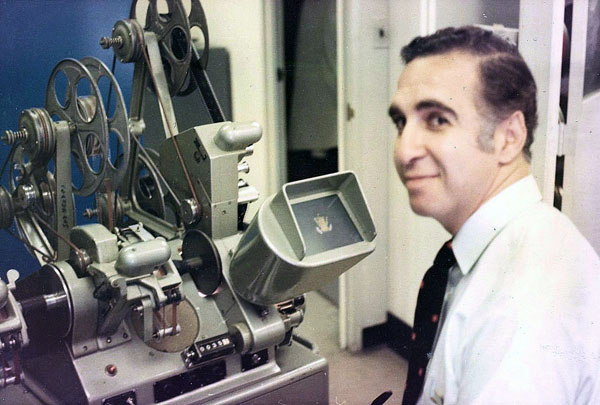
Because, frankly, shows like THE ARCHIES and SCOOBY DOO used ‘limited’ animation. We connoisseurs of complete animation relied on TV commercials to provide our fix of new material. Jack Dazzo’s versatility made him an anonymous favorite. He supplied the gamut. Dazzo could do subtle realism, or Pop Art abstraction.
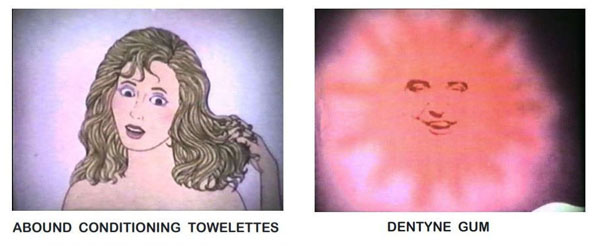
On the far end of the spectrum, Dazzo was able to imitate the juvenilistic style of Fred Mogubgub that was then in fashion.
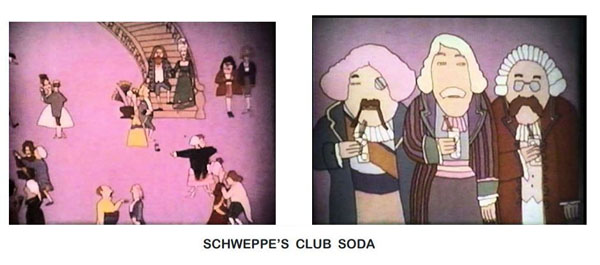
A good deal of Jack Dazzo’s work was just playful.
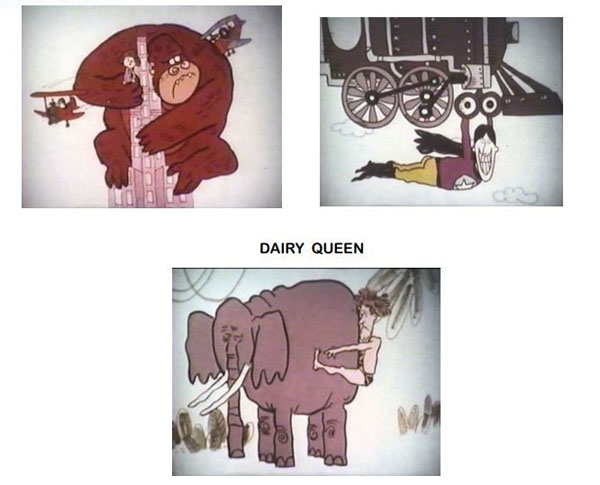
At times it could be a bit scary.
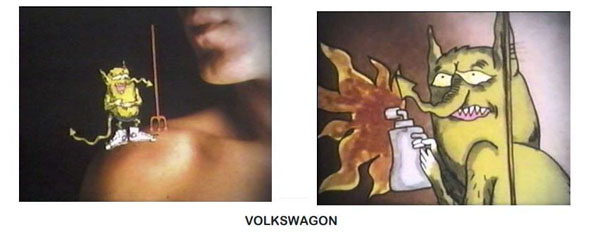
Samples of Jack Dazzo’s work can be seen on one of his demo reels:
Jack Dazzo passed away in 2018, just shy of his 92nd birthday.
Many thanks to Donna Dazzo for her patience and assistance in preparing this article.
ADDENDUM: At some point Jack Dazzo was asked to speak publically. These are his notes (click thumbnails to enlarge):



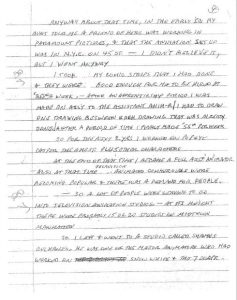
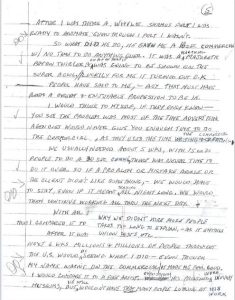
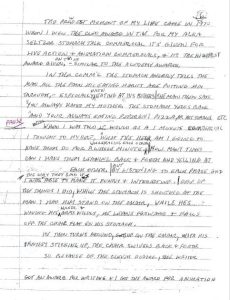
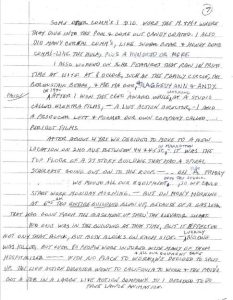




 BOB COAR made his way in this world as a muralist and sign painter, illustrating on just about every surface imaginable. A life-long fan of animation, he is currently searching for digital, or actual, copies of Top Cel.
BOB COAR made his way in this world as a muralist and sign painter, illustrating on just about every surface imaginable. A life-long fan of animation, he is currently searching for digital, or actual, copies of Top Cel. 









































“Have another Nutter Butter peanut butter sandwich cookie!” Hip characters in top hats were all the rage then: Willie Wonka, Doctor Doolittle, the Cat in the Hat, Timer, the Nutter Butter guy…. As for Screaming Yellow Zonkers, I loved the commercials, but the cookies themselves were atrocious.
I remember so many of these. I think the one for Clairol Herbal Essence was the most beautiful commercial ever created for television.
And Fruit Pie the Magician! Did Jack Dazzo animate Twinkie the Kid as well? “Here’s yer RE-ward!”
Paul has a good point about that Clairol Herbal Essence commercial. It really stood out in the ‘seventies.
Being born in 1961, I’ve been entertained for most of my life by a man whose name I only saw as a footnote in OF MICE AND MAGIC. I vividly remember practically every commercial you mentioned, Bob. Thanks for the research, giving credit where credit is due.😃
Not to mention “I’m Just A Bill”, which I never knew he worked on. Jack Dazzo is dazzling!
I used to eat box after box after box of Screaming Yellow Zonkers (it wasn’t cookies, it was candy-glazed popcorn). And now I know whom to thank.
I salute you, Jaxk Dazzo!
Terrific and exhaustive research.
Thank you so much, Bob. If only we could learn as much about the countless animated commercials that appeared on television.
Such a memorable commercial. And a then-unknown Gene Wilder voiced the stomach.
” an AT&T campaign pitching the Yellow Pages – sort of a paper version of Google for local phone numbers.”
(snicker)
It was bound to happen we’d get a line like that nowadays.
What a career. What a talent. How could he not be better known? He’s one of the reasons animated commercials are the best kind.
Thank you, Bob Coar.
WOW! This was instant nostalgia for me! I remember just about every one of those commercials! Great animation and just pure FUN to watch!
Paul, you must have meant to say “glazed popcorn” not cookies regarding SCREAMING YELLOW ZONKERS – but, as a kid, I really did like those! The NUTTER BUTTER PEANUT BUTTER SANDWICH COOKIES? I’d be surprised if you didn’t like those “back in the day,” because they tasted the way peanut butter sandwich cookies are SUPPOSED to taste! The newer version has a vanilla cookie base with peanut butter flavor to save some bucks! I believe the original cookies were peanut butter and tasted superior to the way the cookies taste NOW!
Nice to hear Jackson Beck and Allan Swift (I think) doing some of the voices on some of the cartoons!
Bob, great research! Keep it up!
You’re right, I misspoke about the Zonkers. To tell you the truth, I honestly don’t remember ever eating Nutter Butters back in the day; my parents generally bought cheap no-name brand cookies, or Girl Scout cookies when my sister was selling them. But I do remember the commercials. “How can I have another Nutter Butter peanut butter (gasp) sandwich cookie, when I haven’t had any yet?”
Like others, I cannot sufficiently praise Bob Coar for his thorough and engaging coverage of the New York animation scene.
Another stellar post here Bob, a good chunk of my TV memories from the 70’s are because of the animated commercials.
I remember Jack. Nice fellow. Thanks for all that detail.
Tom, thanks. He was a nice fellow. I’m his daughter Donna. I miss him.
Thank you for your wonderful comments! 💕